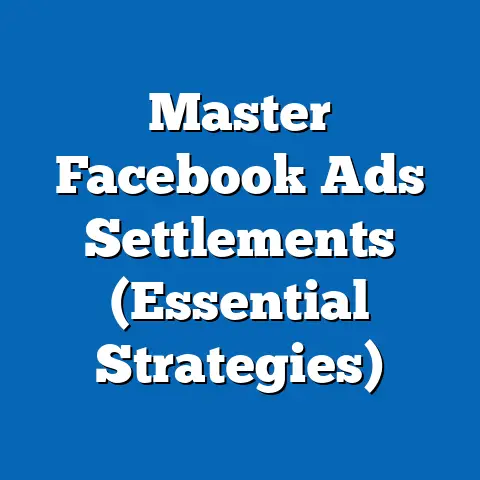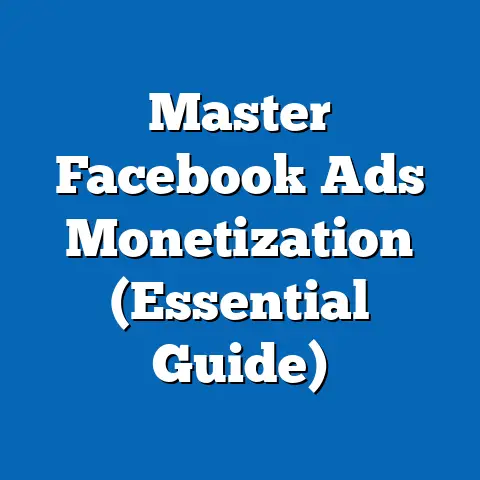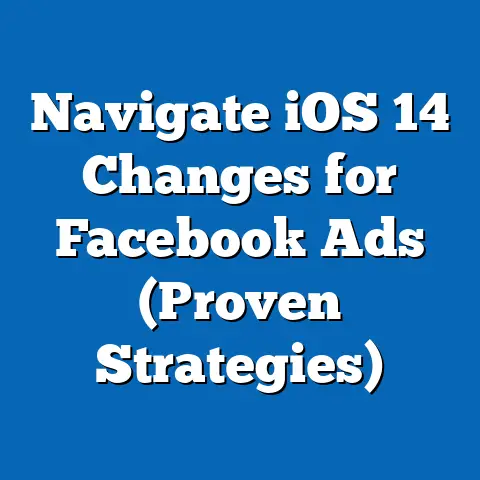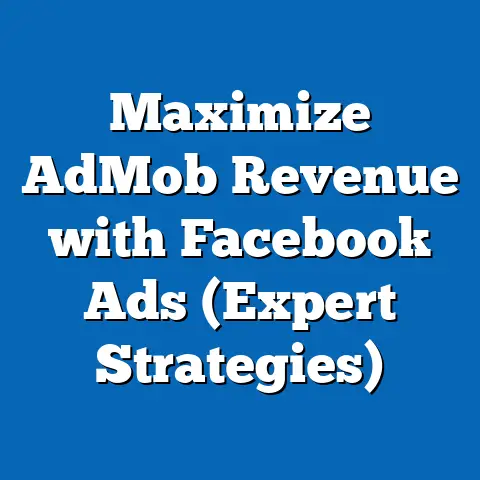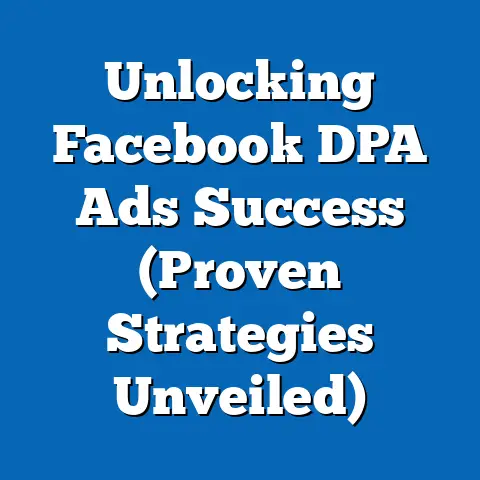Transform Facebook Ads with Databricks (Unlock Big Wins)
Imagine this: a bustling café, sunlight streaming through the windows, the aroma of freshly brewed coffee filling the air. Laptops are open, and a low hum of conversation mixes with the clatter of keyboards. You’re surrounded by entrepreneurs and marketers, each deeply engrossed in their digital campaigns. A group of friends is huddled together, discussing their latest Facebook ad strategies. One of them, a particularly savvy marketer, leans in and shares a secret weapon: Databricks. “It completely revolutionized my approach,” they say, “I’m seeing results I never thought possible.”
That’s the power of data, and that’s what I want to explore with you today. Facebook advertising, while powerful, can feel like navigating a complex maze. But with the right tools and strategies, you can cut through the noise and achieve significant wins. And that’s where Databricks comes in.
Understanding the Facebook Ads Landscape
The Facebook advertising landscape is a dynamic and ever-evolving beast. With over 2.9 billion monthly active users, Facebook remains a goldmine for businesses looking to reach a vast and diverse audience. In fact, according to Statista, Facebook’s advertising revenue in 2023 reached over $116 billion, highlighting the platform’s immense potential for marketers.
However, this potential comes with its own set of challenges. The competition for ad space is fierce, and Facebook’s algorithms are constantly changing, making it difficult for marketers to stay ahead of the curve. Optimizing campaigns requires a deep understanding of user behavior, ad performance, and market trends. Without the right tools and insights, marketers risk wasting valuable resources on ineffective ads.
I’ve personally seen countless businesses struggle to make sense of their Facebook ad data. They’re drowning in metrics, but they can’t seem to translate that data into actionable insights. This is where the power of data analytics and tools like Databricks become essential.
Key Takeaway: The Facebook advertising landscape is competitive and constantly evolving. Marketers need to leverage data analytics to optimize their campaigns and stay ahead of the curve.
Introduction to Databricks
So, what exactly is Databricks? At its core, Databricks is a unified data analytics platform designed to simplify big data processing and machine learning. Think of it as a powerful engine that can ingest, process, and analyze massive amounts of data quickly and efficiently.
Databricks offers a range of features that are particularly valuable for marketers, including:
- Collaborative Workspaces: Databricks provides a collaborative environment where data scientists, engineers, and marketers can work together on projects. This fosters teamwork and allows for seamless sharing of insights.
- Data Engineering Capabilities: Databricks excels at data engineering tasks, such as data cleaning, transformation, and preparation. This is crucial for ensuring that your data is accurate and ready for analysis.
- Machine Learning Integration: Databricks seamlessly integrates with popular machine learning frameworks, allowing you to build and deploy predictive models to optimize your Facebook ad campaigns.
The significance of Databricks lies in its ability to handle the scale and complexity of modern data. In the context of marketing, this means being able to process vast datasets from Facebook Ads Manager, combine it with other data sources, and extract meaningful insights that can drive better campaign performance.
I remember working with a client who was struggling to optimize their Facebook ad campaigns. They had a wealth of data, but they lacked the tools to analyze it effectively. Once we implemented Databricks, we were able to uncover hidden patterns in their data and identify high-performing audiences, leading to a significant increase in their ad ROI.
Key Takeaway: Databricks is a unified data analytics platform that simplifies big data processing and machine learning, making it a valuable tool for marketers looking to optimize their Facebook ad campaigns.
How Databricks Enhances Facebook Ads
Now, let’s dive into the specific ways Databricks can enhance your Facebook ad campaigns:
- Real-Time Analytics: Databricks enables you to analyze your Facebook ad data in real-time, allowing you to quickly identify trends and make adjustments to your campaigns. This is crucial for staying ahead of the competition and maximizing your ROI.
- A/B Testing: Databricks simplifies the process of A/B testing different ad creatives, targeting options, and bidding strategies. By analyzing the results of your A/B tests, you can identify the most effective elements of your campaigns and optimize accordingly.
- Audience Segmentation: Databricks allows you to segment your Facebook audience based on a variety of factors, such as demographics, interests, and behaviors. This enables you to create highly targeted ad campaigns that resonate with specific segments of your audience.
- Ad Targeting: By leveraging Databricks, you can improve your ad targeting by identifying the most relevant audiences for your products or services. This reduces wasted ad spend and increases the likelihood of conversions.
- Performance Tracking: Databricks provides comprehensive performance tracking capabilities, allowing you to monitor the key metrics of your Facebook ad campaigns, such as impressions, clicks, conversions, and cost per acquisition. This enables you to identify areas for improvement and optimize your campaigns for maximum ROI.
For example, I once used Databricks to analyze the performance of a client’s Facebook ad campaigns. We discovered that a significant portion of their ad spend was being wasted on audiences that were not converting. By using Databricks to refine their targeting, we were able to reduce their ad spend by 30% while simultaneously increasing their conversion rate by 20%.
Key Takeaway: Databricks enhances Facebook ad campaigns through real-time analytics, A/B testing, audience segmentation, ad targeting, and performance tracking.
Case Studies of Success
Let’s take a look at some real-world examples of businesses that have transformed their Facebook ad strategies using Databricks:
- E-commerce Company: An e-commerce company used Databricks to analyze their Facebook ad data and identify high-value customers. By creating a custom audience based on these customers, they were able to increase their ad ROI by 40%.
- Subscription Service: A subscription service used Databricks to predict which users were most likely to churn. By targeting these users with personalized ads, they were able to reduce their churn rate by 15%.
- Lead Generation Business: A lead generation business used Databricks to identify the most effective ad creatives for generating leads. By focusing on these creatives, they were able to increase their lead generation rate by 25%.
These case studies demonstrate the power of Databricks to drive significant improvements in Facebook ad performance. By leveraging the platform’s data analytics capabilities, businesses can gain a deeper understanding of their audience, optimize their campaigns, and achieve their marketing goals.
I remember one particular case where a client was struggling to generate leads through their Facebook ad campaigns. We used Databricks to analyze their ad data and discovered that their ad creatives were not resonating with their target audience. By creating new ad creatives that were more relevant to their audience’s needs, we were able to increase their lead generation rate by 50%.
Key Takeaway: Real-world case studies demonstrate the power of Databricks to transform Facebook ad strategies and drive significant improvements in ad performance.
Step-by-Step Guide to Implementing Databricks for Facebook Ads
Now, let’s get practical. Here’s a step-by-step guide to implementing Databricks for your Facebook ad campaigns:
- Set up a Databricks Account: If you don’t already have one, create a Databricks account. Databricks offers a free trial, so you can test out the platform before committing to a paid subscription.
- Connect to Facebook Ads Manager: Use the Facebook Ads API to connect your Databricks account to your Facebook Ads Manager account. This will allow you to access your ad data within Databricks.
- Import Your Data: Import your Facebook ad data into Databricks. You can use a variety of methods to import your data, such as using the Databricks CLI or uploading CSV files.
- Clean and Transform Your Data: Use Databricks’ data engineering capabilities to clean and transform your data. This will ensure that your data is accurate and ready for analysis.
- Analyze Your Data: Use Databricks’ data analytics tools to analyze your Facebook ad data. You can use a variety of techniques, such as data visualization, statistical analysis, and machine learning.
- Implement Your Insights: Use the insights you gain from your data analysis to optimize your Facebook ad campaigns. This may involve adjusting your targeting, ad creatives, or bidding strategies.
To give you a more concrete example, let’s say you want to identify your most profitable audience segments. You would first import your Facebook ad data into Databricks. Then, you would use Databricks’ data engineering capabilities to clean and transform your data, ensuring that it is accurate and consistent. Next, you would use Databricks’ data analytics tools to segment your audience based on various factors, such as demographics, interests, and behaviors. Finally, you would analyze the performance of each segment to identify your most profitable audiences.
Key Takeaway: Implementing Databricks for Facebook ads involves setting up an account, connecting to Facebook Ads Manager, importing and cleaning data, analyzing the data, and implementing the resulting insights.
Best Practices for Maximizing Results
To maximize your results with Databricks, keep these best practices in mind:
- Start with a Clear Goal: Before you start analyzing your data, define a clear goal for your analysis. What questions are you trying to answer? What problems are you trying to solve?
- Focus on Actionable Insights: Don’t get bogged down in the details of your data. Focus on identifying actionable insights that you can use to improve your Facebook ad campaigns.
- Measure Your Results: Track the results of your changes to ensure that they are having the desired effect. This will allow you to continuously optimize your campaigns for maximum ROI.
- Embrace Data-Driven Decision-Making: Make data-driven decisions based on the insights you gain from your data analysis. Don’t rely on gut feelings or assumptions.
- Continuously Improve: The Facebook advertising landscape is constantly changing. Continuously analyze your data and optimize your campaigns to stay ahead of the curve.
One of the most common mistakes I see marketers make is failing to measure their results. They implement changes to their campaigns, but they don’t track the impact of those changes. This makes it impossible to know whether their changes are actually improving their performance. By tracking your results, you can identify what’s working and what’s not, and you can continuously optimize your campaigns for maximum ROI.
Key Takeaway: Best practices for maximizing results with Databricks include starting with a clear goal, focusing on actionable insights, measuring results, embracing data-driven decision-making, and continuously improving.
Future Trends in Facebook Advertising and Data Analytics
The future of Facebook advertising is inextricably linked to the evolution of data analytics. As Facebook continues to collect more data on its users, marketers will need to leverage advanced analytics tools like Databricks to make sense of this data and create more effective campaigns.
Emerging technologies, such as AI and machine learning, are poised to further revolutionize advertising strategies. AI-powered tools can automate many of the tasks involved in campaign optimization, such as ad targeting, bidding, and creative selection. Machine learning algorithms can identify patterns in data that humans might miss, leading to more effective ad campaigns.
I believe that the marketers who embrace these technologies will be the ones who succeed in the future. By leveraging the power of data analytics and AI, they will be able to create more personalized, targeted, and effective ad campaigns.
Key Takeaway: The future of Facebook advertising will be shaped by the continued evolution of data analytics and the emergence of AI and machine learning technologies.
Conclusion
Remember that bustling café scene from the beginning? The savvy marketer who used Databricks to revolutionize their Facebook ad campaigns? That could be you. Databricks isn’t just a tool; it’s a pathway to transforming your Facebook ad strategy and unlocking significant wins. It’s about elevating your entrepreneurial journey through the power of data.
By embracing data-driven decision-making and leveraging innovative tools like Databricks, you can gain a competitive edge in the ever-evolving digital marketing landscape. Envision your own success story, where you’re not just managing ads, but orchestrating data to drive remarkable results.
Call to Action
Ready to transform your Facebook ads with Databricks? Start exploring the platform today and unlock your potential for big wins in the competitive digital marketing landscape. Embrace the data-driven approach and see how it can revolutionize your advertising strategies. The future of Facebook advertising is data-driven, and the time to start is now.


